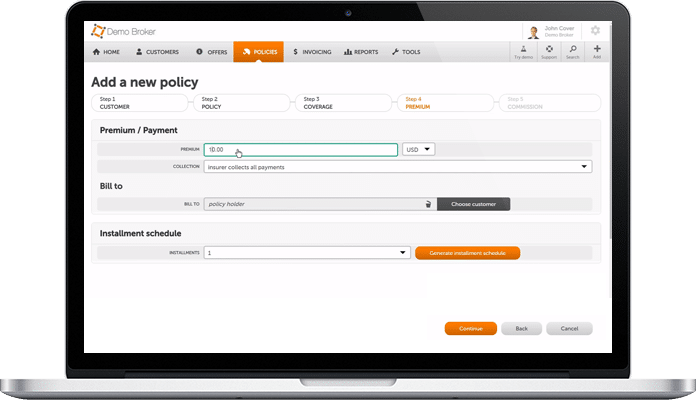Insurance data analytics software relates to the solutions capable of collecting, storing, extraction, and processing relevant information of various kinds obtained from multiple sources. Given the vast amount of such dossiers and records in our digitalized world, the efficient handling of business and personal data can be implemented only via leveraging robust insurance data analytics software as a special kind of insurtech solutions. It will enable players in the domain to draw meaningful insights that can be utilized in optimizing their workflow and providing a higher level of customer satisfaction for their clientele.
Benefits of custom insurance data analytics software
The implementation of a first-rate analytics solution and its integrations with other elements of an organization’s IT ecosystem usher in weighty boons for upgrading the major workflows of an insurance company.
Customer insights and personalization
By collecting and properly analyzing demographic, behavioral, and other information about clientele, insurance companies form a 360-degree view of their customers. Having such individual profiles at their fingertips, they can personalize their marketing efforts and suggest individually tailored services, discounts, offers, etc.
Enhanced operational efficiency
The outcome of data analysis allows insurance companies to streamline and facilitate their shop floor routine, identify and forestall risks, boost decision-making, and increase the productivity of employees.
Improved pricing strategy
In-depth product profitability analysis, conversion ratio, retention ratio, and other indices are keys to revising an insurance organization’s existing pricing policy and modifying its underperforming elements.
Claims processing automation
Data analytics software drastically accelerates the entire lifecycle of handling claims (from the notice of loss through damage assessment to payment processing), pinpoints suspicious claims, helps minimize fraud and prevents litigation.
insurance data analytics dashboard
Get professional consulting on data analytics software for insurance
Use cases of data analytics software by insurance type
We develop predictive analytics insurance software that can support different types of insurance businesses. Below are some examples of what indicators can be tracked:
- Life insurance: Risk scoring, lapse prediction, and policyholder retention analysis.
- Health insurance: Claims fraud detection, provider performance analytics, patient journey mapping.
- Property & Casualty (P&C): Catastrophe modeling, claims trend analysis, underwriting automation.
- Car insurance: Telematics data analysis, driver behavior scoring, and dynamic pricing.
DICEUS approach to building data analytics for insurance
In numerous successful insurance data analytics projects DICEUS has delivered for insurance companies, we prioritized three mission-critical aspects of such an analytics platform.
Example dashboards
Wealth management dashboard
Customer data dashboard
Reports dashboard
Stock history executive dashboard
Homerun auto-insights dashboard
insurtech dashboard benefitpulse
About DICEUS
Our achievements
Our partners








Insurance data analytics pipeline
A data analytics routine is established for each particular case depending on the customer’s needs. However, the typical procedure of setting up an efficient data analytics pipeline for an insurance company covers the following steps.
The type of analytics you will opt for depends on the nature of the data it will be leveraged to process. A more elaborate scrutiny may necessitate utilizing diagnostic, predictive, or prescriptive methods, but descriptive analysis will suffice for a simple overview of data.
Integration capabilities
To automate processes and unlock real-time insights, the best insurance analytics software should be integrated with other systems like policy administration solutions, claims management systems, CRM tools, etc. Here are the key systems to integrate data analytics with:
- Policy administration. The goal of data analytics integration with policy administration is to get data to analyze customer segments, monitor policy trends, and optimize underwriting rules.
- Claims management. The purpose of this integration is accessing structured and unstructured claims data to detect anomalies, forecast reserves, and automate approvals.
- Customer relationship management. The aim of integrating data analytics with a CRM system is combining behavioral data with claims and policy info to create personalized offerings.
To conduct integration successfully, our team will prepare an integration plan, containing all necessary details on ETL pipelines, APIs and microservices, data warehouses, and more.
Estimate project costs
Please share more details of your project with our team.

Our ready-made data analytics solution for insurance
Our insurance data analytics solution is a data visualization tool that captures and analyzes data ingested from our ready-made software products for insurance (Mobile App, Chatbot, Web Portal) to track metrics on sales, claims, and customers. It provides information that helps insurers optimize their cross/upselling strategies and learn where most of sales and marketing efforts should be targeted.
Vitaminise Data Analytics
Other ready-made software for insurance businesses
- AI-Based Underwriting Workbench
- Group and Individual Insurance Management Platform
- Policy Administration System
- Mobile App that supports different types of insurance
- Customer Web Portal
- Insurance Data Warehouse
- AI-Powered Chatbot
Client reviews
Our case studies
FAQ
What are insurance data analytics software development services?
IT vendors offer various services related to creating and implementing data analytics software for insurance agencies. Here belong the development of a standalone custom analytics solution or an embedded module from scratch, customization and integration of third-party analytics software with the existing infrastructure, migration of the analytics product, modernization of a legacy solution, etc.
How does insurance data analytics software development work?
It starts with the discovery phase when the vendor learns the project requirements, scope, budget, and timeframe. All these factors condition the choice of the underlying software architecture and data processing model (ETL, ELT, or ETLT). Then comes the implementation of the model during the development stage, testing the finished solution, and its deployment for further use. Solid vendors also include support and maintenance services in the deal.
What are the benefits of using custom insurance data analytics software development services?
By commissioning a bespoke insurance data analytics solution, you will obtain a unique product that will be honed to meet your organization’s requirements and dovetail into your company’s business goals. Leveraging it, you can step up your pipeline efficiency, improve your pricing strategy, obtain meaningful insights into customer behavior, and guarantee maximum customer satisfaction for your clientele.
What types of insurance companies can benefit from data analytics solutions?
All insurance sectors can benefit—life and unit-linked products, health, property & casualty (P&C), travel, and car. Each type can use data analytics for risk assessment, claims optimization, customer insights, fraud detection, and pricing strategies.
How do you ensure data quality and accuracy in analytics?
We organize rigorous data cleaning, validation, and normalization processes during ingestion. Additionally, automated quality checks and manual audits help support high data accuracy throughout the pipeline.





















